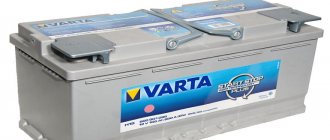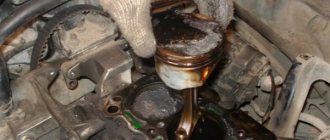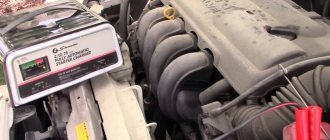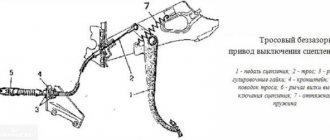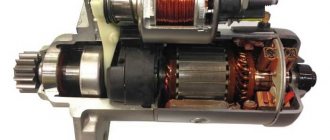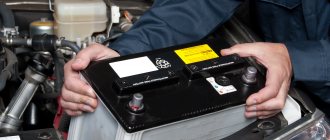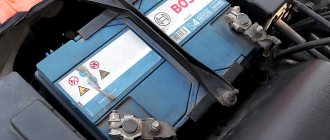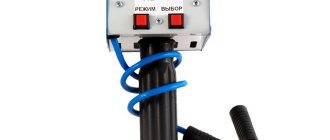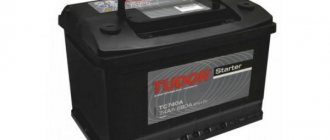How to remove the battery from a car? The issue requires serious investigation. The battery is the most important component of any modern car. After all, the battery powers multiple electronic devices, various heating, adjustments and the entire electrical system as a whole. Therefore, the battery must be removed periodically to recharge.
Removing the battery from a car is, at first glance, a simple operation. But only for the first one. You need to approach the process with all responsibility, because the battery in a car can produce significant current that can melt a wrench if there is a short circuit.
Naturally, in modern cars, most systems that are controlled electronically, a voltage surge without knowing how to properly remove the battery can damage the electrical circuit, and with it the entire car. Therefore, if you do not want to spend money on expensive repairs from an auto electrician, find out how to properly remove the battery from this publication.
What is the service life of a car battery?
A set of necessary tools
In order to properly disconnect the battery on a car, the technician will need a special tool and some available tools. The list of essentials includes:
- a set of attachments and an extension for the wrench;
- gloves for work with good insulation;
- unnecessary dry toothbrush;
- protective glasses;
- small wooden pallet;
- purified water;
- baking soda;
- clamps.
We recommend: Features of Korean car batteries All this should be prepared in advance so that you don’t have to look for the right tool later when the battery is disconnected.
What tool will you need?
To remove the battery from the car you will need the following tools:
- 10 open-end wrench. Use it to remove the terminals;
- A 13 mm wrench with a ratchet for unscrewing the battery mount.
Additional tools may be required if the battery has any non-standard mountings.
Attention! Do not forget about safety precautions when carrying out work. To protect your hands, wear cotton gloves. If you work with electrolyte, use rubber gloves. It is advisable to have baking soda nearby to neutralize the acid if necessary.
Additionally, you can read the article on how to open the car if the battery is dead and the alarm does not work.
Preparing for work
To begin with, if you don’t already know, find out exactly where the battery is located in your car. In a modern car, the battery can be located in various (sometimes unexpected) places: in a niche in the trunk floor, under the rear seat, under the front seat, in the floor under the passenger’s feet.
Preparing for work
Before dismantling the battery, you should acquire knowledge and prepare the necessary tools.
Carrying out careless work can result in battery damage or failure of other vehicle systems.
Any work with the battery should be carried out with rubber gloves. If the hermetic integrity of the structure is violated, this will prevent electrolyte from getting on the skin.
Flammable anti-corrosion substances and the electrical charge present in the battery are also dangerous. So, to carry out work on dismantling the battery, you will need to prepare the following tools:
- rubber gloves and safety glasses;
- open-end wrench No. 10 for removing terminals;
- a wrench for unscrewing the battery fasteners (approximately No. 13, but the choice depends on the type of fasteners).
Before carrying out any operations under the hood of the car, be sure to turn off the ignition. Make sure all electrical appliances are turned off. The ignition key must be removed. Please note that some alarms have the function of locking the window and door when the power is turned off. It is better if the ignition key is in your pocket when you remove the battery, and not in the car.
How to remove a battery with stuck terminals
It often happens that the terminals or one of them become oxidized (covered with a white coating). In this case, they must be cleaned with a brush before removal. It should be quite rigid, but not iron. In case of strong sticking, it is better to use a contact cleaner (ABRO, LIQUI MOLY), they are sold in all car dealerships. If there is no special product, you can simply clean the contacts and use WD 40 lubricant. The process looks like this:
- Treat the terminals with solvent.
- Carefully hook the bottom of the terminal with a screwdriver and wiggle it.
- Try to twist the terminals in different directions until you can remove them.
It is important to use minimal force during the process, otherwise the battery contacts may be damaged.
Important! Some owners tap the oxidized terminals with a heavy object to remove them. This should not be done under any circumstances. Due to such actions, the terminals may permanently fail or fall apart into small pieces.
What to do to prevent the terminals from sticking
To avoid sticking, the terminals should be treated with a protective agent. Of the modern compositions, the most popular are:
- Molykote HSC Plus is a high electrical conductivity product that operates at temperatures from -30 to +1100 oC;
- "Ciatim" - has good electrical conductivity characteristics at a low cost;
- German spray lubricant Liqui-Moly - protects well from oxidation and promotes stable voltage supply.
Drivers who prefer time-tested products opt for Litol or Negrol formulations. A mixture of grease and graphite lubricant also helps a lot.
Do-it-yourself dismantling - sequence of actions
Before dismantling, you need to open the hood and see how your battery is secured. Usually it is secured with a special bracket or tie (sometimes even a plate) so that it does not jump around the engine compartment. To remove this tie, we look at how it is attached - usually the nut is at “10”, but it can also be at “12” - “13”.
There are batteries that are mounted not in the engine compartment, but under the seat of the car, again on luxury cars, where to remove them, they usually dismantle the front seat and the driver.
Next, let’s look at how the terminals on the battery are connected. In 95% of cases these will be nuts at “8” - “10”.
Thus, before dismantling, we stock up on keys in “8” - “10”, as well as “12” - “13”. It is also worth taking gloves, at least “rag” ones, so as not to get your hands dirty.
Let's move on to removing the battery:
- Open the hood
- Remove the battery noise insulation or fabric protection. Happens on some cars.
- Remove the negative terminal! It is marked with a “minus” on the battery case. Why do you need to shoot her first? In principle, it makes no difference to the battery which one is removed first, but the “negative” one is screwed to the car body. If you first remove the “positive” terminal and accidentally touch a metal element of the body with the key (which is located on the “plus” nut), a STRONG SHORT WILL OCCUR! Therefore, first of all, we turn off the power to the body (remove the “minus”), and only then remove the “plus”.
- We remove the fasteners that hold the battery. As I wrote, this could be a bar across the entire battery, or maybe just a plate at the bottom.
- We pull it out of the seat.
Actually, this is all, as you can see, it’s no big deal, just basic actions.
Possible problems when removing the battery
When removing the battery, the owner runs the risk of encountering some problems. Their specifics depend on the equipment of the machine. For example, there are nuances for cars with a radio, alarm and on-board computer.
With alarm
When the battery is disconnected, malfunctions in the operation of your car alarm may occur, namely:
- loss of one or more keys/remotes;
- failure to operate any additional alarm functions.
If this happens, then to restore the alarm, you will need to contact a specialized service.
It should be noted that malfunctions of the alarm when the battery is disconnected are quite rare.
On-board computer
The on-board computer is responsible for the operation of all the electronics of a modern car. Usually it has separate power supplies where the most important settings are hidden, but their resource may be exhausted. In this case, the computer begins to be powered from the common system.
Some cars may have several on-board systems (for example, the Volkswagen Faeton has 6). After removing the battery, they all turn off and important settings are lost. To avoid unnecessary problems, in this case it is better to contact a service station to remove the battery.
Removing the battery is a procedure that must be approached responsibly and seriously. If you follow the instructions, you can avoid a lot of troubles, from a harmless failure of the settings in the radio to significant damage to the electronics and the battery itself.
With radio/cassette player
Before removing the battery, check whether your car radio is equipped with a security PIN code. If yes, then make sure you have the correct PIN code.
Remove the terminal to clear the error
Well, in conclusion, I would like to answer another popular question - namely, will the error go away, for example, if you remove the terminal for, say, 10 minutes or even an hour?
It is worth noting that this is from the realm of myths! Removing neither “plus” nor “minus” usually does not help against serious errors. They are, so to speak, registered at the level and often you need special software and special devices like , to make the connection - read and then reset the error.
Of course, there used to be ECUs that could be manipulated in this way. YES, and some VERY easy errors were reset, for example regarding fuel.
But in modern cases, in 97% of cases, this will not help! It's not like a microwave where the clock resets every time the power goes out. Once again, everything is sewn up and accumulated programmatically, you can’t just reset it.
YES, and if we are talking about errors, you need to remember that if you “threw away” errors using ELM327, but did not eliminate their cause (for example, the catalyst “bent over”), then they will reappear after a very short period of time.
A car battery is needed to start the engine and operate electronic systems when the engine is turned off. It should be maintained in working condition - properly cleaned of deposited sodium carbonate elements, check the electrolyte level and charge if necessary. To carry out maintenance work, sell or replace the battery, it must be removed from the car. There are certain rules that indicate how to remove the battery from a car, and what precautions must be taken when doing so.
What not to do with a battery
- damage the body;
- damage the filler plugs and their necks;
- turn the battery over or strongly tilt it;
- damage contacts (for example, by trying to force unsuitable wire terminals onto them);
- store a discharged battery (especially at sub-zero temperatures);
- add acid.
Important: if it is discovered that the electrolyte level in one or more jars is below normal, only distilled water can be added to them.
Precautionary measures
Remember - the battery is quite heavy. Hold it firmly and try to avoid impacts to avoid damaging the battery case.
Important! If battery acid gets on your skin or clothing, wash the area with a solution of regular baking soda. If there is no soda, simply rinse the areas where the acid has come into contact with plenty of water.
If you have an alkaline battery, then if alkali gets on your clothes or skin, you will need to wash them with an acid solution. (Regular citric acid or a 10% vinegar solution is suitable for this).
It is best if you wear protective gloves when removing the battery.
When the battery is operating, hydrogen is released from it through the ventilation holes. This gas is extremely explosive. Even a small spark from an accidental short circuit can, under certain conditions, lead to an explosion. Therefore, it is better to work on the battery in a well-ventilated area or in the air.
Procedure and precautions
Before you begin removing the battery, you need to make sure that the engine is turned off. If you remove the battery while the engine is running, then at this time voltage from the generator will be supplied to all control units of the vehicle.
If the generator voltage regulator relay is faulty, then an increased unstabilized voltage (more than 15.5 Volts) may be supplied to the electronic units. In most situations, this leads to failure of the car's electronics. Repairs are extremely difficult and expensive.
Under no circumstances should you remove the battery while the engine is running!
Before removing the terminals from the battery, you must make sure that the ignition is turned off. If you disconnect the battery while the ignition is on, very serious problems with the immobilizer are possible. If there is a failure in the immobilizer system, the key will become untied, and further starting the engine will be problematic without an auto electrician.
Procedure for removing the battery:
- Determine the location of the battery installation. If it is installed in the trunk, make room for work. If the battery is located under the seat, it is necessary to remove or raise the slide according to the vehicle operating instructions.
- Remove the battery mount from its original location. This can be a special bracket or bracket. Usually they are removed using a 10 or 13 key.
- If a gas outlet (a tube for removing gaseous products from the plate container) is connected to the battery, disconnect it. It is advisable to place the tube in a previously prepared container.
- Proceed to disconnect the terminals. In order to properly disconnect the terminals, the following removal sequence must be followed:
- the negative (minus) terminal should be removed first (in this case, if you accidentally touch the body metal parts or ground of the car with the key, there will be no short circuit);
- After disconnecting the negative terminal, proceed to disconnecting the positive terminal.
If one of the terminals is stuck, you can use silicone grease or brake fluid to free it. It is better not to use WD-40, as it is highly aggressive towards lead.
Do not use strong mechanical forces when removing terminals!
Even a minor crack in the housing in the contact area will lead to further formation of chemical oxides on the terminals. To dismantle the terminals, a 10mm wrench is usually used.
- After disconnecting the terminals, remove the battery from its original location and place it on a stable surface.
After the battery has been removed from the car, it is recommended to wipe it from moisture and dirt, after which you can begin the planned work with it.
Have you ever had to remove the battery from a car? Then tell us about your experience in the comments, this will greatly help other car enthusiasts and make the material more complete and accurate.
Removing the battery may be necessary in different situations. For example, when updating, repairing or selling a car. The disconnection process itself consists of simple and understandable steps. Anyone who knows how to use a screwdriver and wrench can handle this task. However, there are several important points that must be taken into account, since you can accidentally damage the working systems of the engine. This article contains comprehensive information on how to remove the battery from a car.
Almost all car manufacturers include instructions for the battery removal process in the operating instructions. Therefore, all the necessary information is located there. Sometimes there are machines that have a special shield for disconnecting the mass. Also, some models are equipped with a toggle switch in case of unexpected battery disconnection. It is worth paying attention to these details when studying the car’s instructions.
Additionally, you can protect yourself from spark slippage by purchasing an inexpensive fuse. It is attached to the negative cable of the battery. The battery must be handled very carefully. Careless actions can damage the seal of the battery. In this case, the electrolyte will begin to seep through the cracks, which will damage the device.
Safety precautions
Car batteries are heavy, so if the handle is weak, hold it by the bottom so as not to drop it.
If battery acid or electrolyte gets on your skin, immediately rinse with clean water, preferably a solution of baking soda.
Work with the battery, charge it, check the density with a hydrometer, add distilled water, etc. in a well-ventilated area. A working battery releases hydrogen gas through a special small hole in the battery housing.
Installing the battery in the car
The reverse procedure, namely, the correct connection of the battery to the car after work has been completed or if it is replaced with a new unit, also requires compliance with the regulations. The first thing that the work contractor should take into account when installing the battery in a standard seat is its polarity: it is important to place the battery correctly in the car so that the positive “side” of the battery corresponds to the positive wire. It is worth noting that it will not be possible to connect the battery if it is installed inappropriately, since the negative terminal is much smaller than the positive docking mechanism; however, incorrect initial installation is an unnecessary and irrational waste of precious time and effort.
After installing the battery, it is important to securely fix it with standard fasteners, which will eliminate the possibility of damage to the battery during operation of the vehicle, when making sudden maneuvers or overcoming sections of roads with uneven surfaces.
Then all that remains is to figure out how to connect the battery to the car, namely, in what sequence to correctly place the terminals on the battery contacts so as not to cause a short circuit in the wiring, and to complete the battery installation process correctly. It would be correct to initially place the “positive” terminal on the corresponding battery contact, and tighten it tightly with a fastening nut, and only after that connect the negative terminal in the same way. At this point, the technical work on replacing the battery on the car can be considered completed; all that remains is to restore the on-board settings of the car.
And one more tip: before connecting the terminals, it is correct to lubricate their contact surfaces with an anti-corrosion substance or oil intended for processing electrical connections. The procedure is necessary to eliminate the possibility of deposits appearing on surfaces, and to facilitate the removal of terminals if there is a repeated need to replace or remove the battery before servicing the battery or vehicle in the future.
Procedure for removing the battery from the car
So, removing the battery from the car is carried out in a certain order:
- Turn off the ignition.
- Turn off all electronics in the car that operate without the ignition.
- Close all windows and doors in the car.
- Unscrew the cover that prevents dust and dirt from accumulating on the battery terminals.
- Disconnect the grounding if the machine was previously grounded.
- There are batteries with or without a protective cover. If there is no protective cover, in order to avoid a short circuit, insulate the “plus” with technical tape or use an ordinary plastic cap - this will protect the further process of removing the terminals;
- Carefully loosen the ground nut with a wrench.
- Now disconnect the terminals . The main question is which terminal to remove from the battery first? There is a strict rule: first remove the negative terminal, and only then remove the positive terminal .
- Do not allow the positive pole to come into contact with metal parts of the machine..
An important technical point: it is the negative pole that needs to be disconnected first because this prevents a short circuit from occurring due to the fact that the mass remains without potential.
The mass is nothing more than the car body, which is connected to the negative terminal of the battery. When this terminal is removed, the battery is first disconnected from the body. The electrical circuit running from the negative potential of the battery to the car body is temporarily broken, and a short circuit will no longer occur. As you can see, removing the terminals from the battery is not difficult - the main thing is not to overdo it with force. And when removing, be extremely careful not to confuse the polarity and prevent a short circuit in the electrical circuit, which could be fatal.
Next, you should carry out the necessary actions (either replacing the old battery with a new one, or charging it), and then proceed to install the battery back. Immediately before this, clean the terminals with soda and a stiff brush, and if there are any deposits on them, remove them with distilled water. Do not use ordinary water to avoid the formation of salts.
Restoring the on-board computer
When the car is de-energized, which occurs after the battery is disconnected, some vehicle models may simultaneously undergo zeroing of all electronic sensors and systems. A similar precedent is relevant for cars equipped with modern on-board computers, the settings of which are lost when the battery is removed, which calls into question the further functioning of the car in standard mode.
To resume on-board settings you will have to perform the following simple manipulations:
- After installing the battery, according to the regulations, turn on the ignition and warm up the engine to operating temperature.
- Remove the negative terminal for a few minutes, then fasten it back.
- Start the engine again and let it run for about fifteen minutes, which will allow the electronic systems to record information about the operation of the base sensors.
- Save the recorded information by simply turning off the ignition.
- Start the car again and check its operation in all operating modes. For this purpose, it is enough to perform a short “test drive” in safe conditions, with a gradual increase in speed, sharp acceleration and stopping, and then turning off the ignition, which will be the final stage of setup. Computer systems will automatically record the data obtained as a result of the test ride.
At this point, the restoration of on-board settings is considered complete, and the vehicle can continue to be operated in normal mode.
About a running engine and battery
REMOVING THE BATTERY FROM THE CAR IS WITH THE ENGINE STOP! The manufacturer cannot dismantle the process while the engine is running, especially on modern cars. There are several reasons:
- When the engine is running, charging occurs from the generator. And if you remove the battery, the positive terminal can get on the car body, a short circuit will occur - it is possible to burn the generator, wiring, and just your car.
- Disconnecting the battery while the engine is running can cause a voltage surge in the on-board network. You can set fire to the ECU, generator relay-regulator , alarm system and other systems (in particular multimedia)
I think these two points are already enough. The LAST thing to remember is that you need to remove the battery with the ignition off! It is IDEAL to remove the key from the ignition altogether. When the ignition is running, voltage surges can also occur, and it is also possible to “burn” something.
And this is where the text version ends, the main thing to remember is - turn it off - take the key out of the lock - go dismantle the battery - EVERYTHING!
Now there is a detailed video version, which will be useful for beginners.
Read our AUTOBLOG, subscribe to updates, it will be interesting.
Similar news
- How to light a battery from another car. Is it possible to do this...
- Which company (brand) to choose a battery for a car. My rate...
- Lubricating battery terminals. Why does a car need this?
Recycling an old car battery
Failed units are not installed in the car. They must be disposed of because toxic and harmful materials were used for their preparation.
Full or partial disposal is carried out by special organizations. They operate according to a proven scheme:
- Draining and neutralization of spent electrolyte.
- Crushing the body on special machines.
- Removing debris and metal residues from the lead-acid mixture.
- Lead separation and purification.
- Re-preparation of purified lead products.
Battery and running engine
The car battery can only be removed with the engine turned off. It is prohibited to dismantle the battery while the engine is running. And it is important to take this into account when we are talking about modern cars equipped with on-board computers.
Basic moments:
- When the engine is turned on, a charge is constantly supplied from the generator. When dismantling, the positive terminal hits the body, resulting in a short circuit. This can harm not only the generator, but also the entire wiring and on-board network.
- If the battery is disconnected without permission, a voltage surge occurs. Increased voltage affects the performance of the relay regulator, alarm system, and other components.
- The power source is turned off when the ignition is turned off.
- Dismantling is carried out in accordance with the requirements and standards that are recorded in the technical documentation.
Choosing a new car battery
It is prohibited to install a battery that has exhausted almost its entire working life. Therefore, you need to know how to choose a new power source.
The choice of battery, as well as the choice of a car, must be taken responsibly. When choosing a battery, you need to take into account the information recorded in the technical documentation. Manufacturers list all technical parameters and characteristics. Therefore, the selection will not take much time.
When viewing catalogs with modern units, you need to consider:
- Capacity. The nominal value for the new and “original” batteries must be the same. It is not recommended to purchase devices with large capacities.
- Current strength. The average value for a battery is about 480 A. Among the presented models, choosing a device with this parameter is not difficult.
- Polarity. Manufacturers supply car batteries with reverse and direct polarity. They connect differently.
- Dimensions of the device and terminals. Various manufacturing companies supply power supplies with thin, thick, and oversized terminals. But you need to take into account not only the dimensions of the car terminals, but also the design features of the power source and vehicle. After all, even minimal inconsistencies will complicate the installation process.
- Manufacturer. When choosing a manufacturer, you can be guided by the recommendations of the car manufacturer, advice from experts, and personal preferences.
- State. Appearance assessment is a mandatory step. The power source must not be deformed. It should not have cracks, chips or other damage.
- Checking the markings. The power source is marked with a number of symbols. The marking includes the type of battery, permissible temperature, capacity, polarity, and current value.
After selecting 2-3 models for subsequent installation of batteries in the car, testing is carried out and the final choice is made.
The new battery must be installed in the car in the same order as the previously used one.
Precautionary measures
Dismantling and installation of car batteries is carried out taking into account the rules:
- To work with electrolyte, you need to prepare thick rubber gloves and protective clothing. After all, the electrolyte contains sulfuric acid. Contact with this substance causes burns. To neutralize the acid, you will need baking soda. It needs to be prepared in advance.
- The alarm is turned off until the power supplies are replaced. After all, it can work at the most inopportune moment.
- The terminals and leads are treated with a special lithium grease. It helps minimize the likelihood of oxidation. The composition must be applied carefully.
- Before installation, the condition of the seals, housing, leads, and other elements is checked. Installation of damaged or leaking power supplies is not recommended.
- After installing the battery, the functionality of all systems is checked. If necessary, the main systems are restarted. Such precautions and safety are important to consider.
- It is prohibited to place metal structures and objects near the dismantled unit.
- It is prohibited to connect wires from the terminals. Such actions can cause a short circuit and failure of the restored battery.
- Do not turn the battery over. Electrolyte may leak through loosely closed plugs.
- It is prohibited to add electrolyte during the replacement process. Such actions are performed only when carrying out repair activities.
Battery care rules
Proper care of the plug-in power source will eliminate difficulties and problems for 2–4 years. Among all the rules, several deserve special attention:
- When the engine is turned off, you need to periodically check the strength of the fastening. Even minor displacements provoke vibration, which negatively affects the performance of the device.
- Oxide often forms at the terminal junctions. Anti-corrosion substances are used to remove it. They are easy to find in specialized stores.
- You should regularly check the charge level of the battery. Such actions can only be performed with the engine turned off. A voltmeter is great for checking.
- If the vehicle is not used for a long time, the battery should be moved into the house and the negative terminal should be disconnected.
- Periodically, the unit is cleaned of dirt, electrolyte drips, and other contaminants. For cleaning, it is allowed to use a clean rag or sponge.
The battery life depends on the correctness of the dismantling and installation process. Therefore, all rules and recommendations must be followed. After all, buying a new device is an expensive undertaking.
Sources
- https://prometey96.ru/ekspluataciya/kak-snyat-akkumulyator.html
- https://akbzona.ru/stati/ustanovka-i-snyatie-akkumulyatora-avtomobilya
- https://dongfeng-auto.ru/sovety/kak-snimat-akkumulyator-s-avtomobilya.html
- https://akbinfo.ru/stati/kak-snjat-akkumuljator-s-mashiny.html
- https://dispetcher-gruzoperevozok.biz/kak-snyat-akkumulyator-s-mashiny/
- https://autostuk.ru/kak-pravilno-snyat-akkumulyator-s-avtomobilya.html
- https://DriverTip.ru/repair/kak-snyat-i-podklyuchit-akkumulyator-k-avtomobilyu.html
Why do you have to remove the car battery?
Cases of dismantling a battery in automotive practice are not isolated. The main reasons why you have to shoot are:
- replacing a worn-out battery with a new battery;
- charging the battery in stationary conditions;
- performing routine battery maintenance (replacing electrolyte, checking density, restoring functionality, etc.);
- placing the battery in temporary storage during long-term parking of the car;
- driver assistance when starting a third-party car;
- carrying out vehicle repair work;
- the battery terminal (usually negative) is removed to reset individual settings of some systems, error codes of vehicle control units (without dismantling the battery);
- dismantling the battery in an emergency (if the engine compartment is damaged);
- carrying out pre-sale preparation;
- washing the engine with special means (if the battery is installed under the hood);
- cleaning the interior or trunk (if the battery is installed there regularly).
These are the most common cases, but in life there can be much more.

